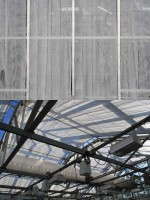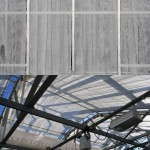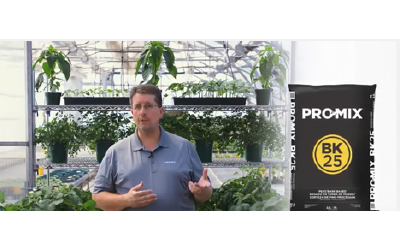Keeping Cool With Greenhouse Shading

Shade is used to reduce the temperature and light inside a greenhouse. The radiant energy from the sun can easily build up inside of a greenhouse during the summer and increase temperatures beyond the desired range for many crops. Additionally, light levels in the summer regularly exceed the usable level by plants, and excess light may result in high-light damage. However, the use of shade cloth can often reduce the air temperature by up to 10°F (5°C) and light levels by up to 75 percent or greater, depending on the shade material used.
Two Ways To Provide Shade In A Greenhouse
Â
There are two primary options for providing shade: shading compound or whitewash; or shade curtains or shade cloth. Each of these options has distinct advantages and disadvantages, which warrant consideration when deciding how to reduce light and temperature in the greenhouse.
Shade compound, or white wash, is a paint-like substance applied to greenhouse covering. The magnitude of shading for shade compound is dependent on how much the original material is diluted — higher dilution of shade compound results in less shade, whereas a higher concentration of compound increases shading.Â
For best results with shade compound, apply to dry greenhouse glazing materials outside the greenhouse in the morning or in the late afternoon with a brush, roller or sprayer. Be sure to keep an eye on the weather, as rainfall within 12 to 24 hours after application may wash off the newly applied shade compound. Once the shade compound has been applied, it will consistently provide shading until it is removed by washing in the fall. This means that during periods of low light in the summer such as early morning, later evening, overcast days, etc., incoming light will be further reduced and result in suboptimal light levels.
The costs associated with using shade compound are primarily the labor to apply and remove the shading compound, as the actual material is not very expensive, though the labor costs will be incurred each year shade is applied.
Shade curtains are the other primary choice for reducing heat and light inside a greenhouse. Several factors must be considered when designing a shade curtain system for greenhouses, including shade placement, shade curtain materials, and system configuration.
The first decision to be made is whether to place shade curtains on the exterior or interior of the greenhouse. Shade curtains are placed on the outside of a greenhouse are more effective at reducing temperatures inside a greenhouse because radiant energy from the sun is absorbed or reflected by the curtain outside, before it enters the greenhouse. However, the functional life of shade curtain placed outdoors is reduced due to exposure to the elements like snow. Outdoor shade is usually used in warm, southern climates such as Florida.
Next, you need to select the appropriate type of material for the curtains. Most popular shade curtains are made with aluminized polyester. The percentage of shading is determined by the width of the aluminized strips and the space between strips. Aluminized curtains reflect light and, therefore, minimal energy is absorbed by the curtain, maximizing the cooling benefits of shade. In addition to shading, curtains may be designed to diffuse light, brightening shaded areas and moderating bright spots. Additionally, one of the biggest benefits of shade curtains is that they can also double as an energy curtain when drawn at night to minimize the radiant heat loss and/or the volume of air to be heated.
One of the main advantages of shade curtains is that they can be dynamic, opening and closing based on environmental conditions, minimizing suboptimal light levels as a result of unnecessary shading. You will need to decide which type of curtain configuration will work best for you. Shade curtains are either drawn from gutter-to-gutter or from truss-to-truss. Gutter-to-gutter curtains run the length of a greenhouse and, as the name implies, are drawn from one gutter to another. One disadvantage of this system is that it may be difficult to accommodate superstructure like supplemental lights, electrical conduit and ventilation tubes.
Configurations Of Truss-To-Truss Curtains: There are three types of configurations used for truss-to-truss curtain systems: flat-at-gutter-height, slope-flat-slope, and slope-slope. Flat-at-gutter-height systems draw shade curtains from truss to truss at the height of the gutter. Functionally, the flat-at-gutter-height is similar to the gutter-to-gutter, with similar advantages and disadvantages. The slope-flat-slope design has the shade curtains running parallel with the roof up until a certain height, when the curtain then runs flat for a certain length before sloping with the opposite roof. Slope-flat-slope designs allow for superstructure to be suspended under the shade curtain. Lastly, the slope-slope design is where the shade curtain runs parallel to the roof. These different shade curtain configurations will also affect the balance of warm and cool air masses. Gutter-to-gutter and slope-flat-slope configurations will hold warm air during the day when curtains are used for shading due to the air mass above the curtain; however, when used at night as an energy curtain, these configurations also minimize the air space requiring heating. Alternatively, the slope-to-slope design will minimize warm air above curtains during the day. When used as energy curtains in this configuration, heat loss at night will still be reduced, but the air space to be heated will not be reduced by much.
Using shade to reduce temperatures and light during the summer can improve crop quality and worker comfort inside the greenhouse. However, you will need to evaluate what your goals are and what type of investment you are going to make. Whether it is simply applying shade compound or installing shade curtains, the benefits of using cloth will usually outweigh any investment costs in a short period.
Â
Â
Â
Â
Â









